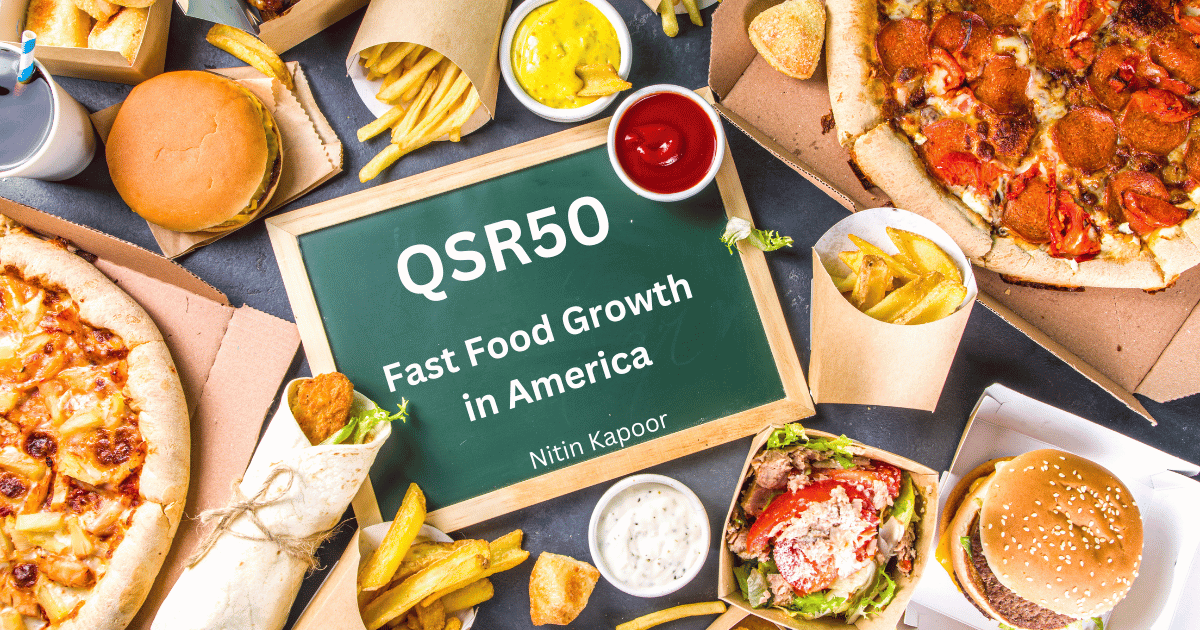Decoding QSR50: Evolving Quick Service Restaurant Growth in America

Introduction to Report
The introduction of the QSR50 report provides an overview of the report’s purpose and highlights the top quick-service chains and their adaptation to the ever-changing landscape of food service. The report is designed to help industry professionals, investors, and analysts understand the trends and challenges facing the quick-service industry and identify opportunities for growth and innovation.
The introduction also mentions that the top quick-service chains experienced a mix of challenges and opportunities within the past year as they navigated shifting consumer preferences, technological advancements, and global events that impacted operations. The report highlights how brands like McDonald’s are using digital, delivery, and drive-thru to enhance their development outlook and experience a renaissance.
Overall, the introduction sets the stage for the rest of the report and provides context for the key findings, trends, and insights that follow.
The methodology used by QSR50

The methodology of the QSR50 report is based on the total systemwide sales of quick-service chains in the United States. The report ranks the top 50 quick-service chains based on their annual sales performance and provides insights into their growth strategies and market share.
To compile the data, the QSR50 team collects information from public filings, company reports, and industry sources. The team also conducts surveys and interviews with industry experts and analysts to gather additional insights and perspectives.
The report uses a standardized methodology to ensure consistency and accuracy in the data. The methodology includes the following criteria:
- Total Systemwide Sales: This includes all sales generated by a quick-service chain, including company-owned and franchised locations.
- Unit Count: This includes the total number of locations operated by a quick-service chain, including company-owned and franchised locations.
- Average Sales per Unit: This is calculated by dividing the total systemwide sales by the total number of units.
- Year-over-Year Sales Growth: This is calculated by comparing the total systemwide sales of a quick-service chain in the current year to the previous year.
- Market Share: This is calculated by dividing the total systemwide sales of a quick-service chain by the total systemwide sales of all quick-service chains in the United States.
The methodology of the QSR50 report is designed to provide a comprehensive and objective analysis of the quick-service industry. It allows industry professionals, investors, and analysts to compare the performance of different quick-service chains and identify trends and opportunities for growth and innovation.
Key Findings by QSR50
The key findings of the QSR50 report are as follows:
- McDonald’s remains the top quick-service chain in the United States, with total systemwide sales of $40.4 billion in 2022. The company’s sales grew by 9.5% year-over-year, driven by its digital, delivery, and drive-thru initiatives.
- Starbucks is the second-largest quick-service chain in the United States, with total systemwide sales of $23.5 billion in 2022. The company’s sales grew by 11.5% year-over-year, driven by its focus on convenience and innovation.
- Chick-fil-A is the third-largest quick-service chain in the United States, with total systemwide sales of $14.2 billion in 2022. The company’s sales grew by 14.5% year-over-year, driven by its focus on quality, service, and innovation.
- Subway is the fourth-largest quick-service chain in the United States, with total systemwide sales of $10.2 billion in 2022. The company’s sales declined by 5.5% year-over-year, due to the impact of the COVID-19 pandemic on its operations.
- Taco Bell is the fifth-largest quick-service chain in the United States, with total systemwide sales of $9.8 billion in 2022. The company’s sales grew by 6.5% year-over-year, driven by its focus on innovation and value.
- Dunkin‘ is the sixth-largest quick-service chain in the United States, with total systemwide sales of $9.2 billion in 2022. The company’s sales grew by 8.5% year-over-year, driven by its focus on digital, delivery, and drive-thru.
- Domino’s is the seventh-largest quick-service chain in the United States, with total systemwide sales of $8.9 billion in 2022. The company’s sales grew by 12.5% year-over-year, driven by its focus on digital, delivery, and innovation.
- Pizza Hut is the eighth-largest quick-service chain in the United States, with total systemwide sales of $7.8 billion in 2022. The company’s sales declined by 3.5% year-over-year, due to the impact of the COVID-19 pandemic on its operations.
- Wendy’s is the ninth-largest quick-service chain in the United States, with total systemwide sales of $7.6 billion in 2022. The company’s sales grew by 7.5% year-over-year, driven by its focus on quality, value, and innovation.
- Burger King is the tenth-largest quick-service chain in the United States, with total systemwide sales of $7.2 billion in 2022. The company’s sales grew by 4.5% year-over-year, driven by its focus on digital, delivery, and value.
Overall, the top 50 quick-service chains in the United States generated a total of $290.2 billion in systemwide sales in 2022, representing a 7.5% year-over-year increase. The report highlights the importance of digital, delivery, and drive-thru in driving growth and innovation in the quick-service industry.
The report also provides insights into the growth strategies of the top quick-service chains, including their focus on convenience, innovation, quality, and value. The report includes tables and diagrams to illustrate the data and trends, such as the top 10 quick-service chains by systemwide sales and the year-over-year sales growth of the top 50 quick-service chains.
Trends and Insights by QSR50

The QSR50 report highlights several trends and insights that are shaping the quick-service industry in the United States. One of the most significant trends is the impact of digital technology, delivery, and drive-thru on the industry. The report shows that quick-service chains that have invested in digital technology, such as mobile ordering and payment, have seen significant growth in sales and customer engagement. Similarly, chains that have expanded their delivery and drive-thru capabilities have been able to meet the changing needs and preferences of consumers, particularly during the COVID-19 pandemic.
Another trend highlighted in the report is the importance of convenience, innovation, quality, and value in driving growth and differentiation in the quick-service industry. The report shows that quick-service chains that have focused on these factors have been able to attract and retain customers, even in the face of rising competition and changing consumer preferences.
However, the report also highlights several challenges facing the quick-service industry, such as labor shortages, rising food costs, and changing consumer preferences. The labor shortage has been particularly acute in the wake of the COVID-19 pandemic, with many quick-service chains struggling to find and retain workers. This has led to increased labor costs and reduced operational efficiency for many chains.
Rising food costs have also been a challenge for the quick-service industry, particularly for chains that rely heavily on commodity ingredients such as beef and chicken. The report shows that some chains have been able to mitigate these costs by focusing on plant-based and alternative protein options, which are often less expensive and more sustainable.
Finally, changing consumer preferences has also been a challenge for the quick-service industry, particularly as consumers become more health-conscious and environmentally aware. The report shows that quick-service chains that have been able to adapt to these changing preferences, such as by offering healthier menu options and sustainable packaging, have been able to differentiate themselves and attract new customers.
Overall, the QSR50 report provides valuable insights into the trends and challenges facing the quick-service industry in the United States. By focusing on digital technology, delivery, and drive-thru, as well as convenience, innovation, quality, and value, quick-service chains can continue to grow and thrive in an increasingly competitive and challenging market.
Case Studies
Here are a few examples of successful quick-service chains that have adapted to the changing landscape of food service:
- McDonald’s: McDonald’s has been a leader in digital innovation, with investments in mobile ordering, delivery, and drive-thru technology. The company has also focused on menu innovation, with the introduction of new items like the McPlant burger and the BTS meal. McDonald’s has also prioritized sustainability, with initiatives like the “Better M” platform, which aims to reduce the company’s environmental impact.
- Chick-fil-A: Chick-fil-A has focused on quality, service, and innovation to differentiate itself in the quick-service industry. The company has invested in technology, with features like mobile ordering and curbside pickup, and has also introduced new menu items like the Mac & Cheese and the Spicy Chicken Sandwich. Chick-fil-A has also prioritized employee training and development, with programs like the Leadership Development Program.
- Domino’s: Domino’s has been a leader in digital innovation, with investments in online ordering, delivery, and tracking technology. The company has also focused on menu innovation, with the introduction of new items like the Chicken Taco Pizza and the Cheeseburger Pizza. Domino’s has also prioritized sustainability, with initiatives like the “Paving for Pizza” campaign, which aims to repair potholes in communities across the United States.
These quick-service chains have demonstrated best practices and strategies for growth and innovation, including a focus on digital technology, menu innovation, and sustainability. By investing in these areas, these chains have been able to differentiate themselves and attract new customers, even in the face of rising competition and changing consumer preferences.
Conclusion of report by QSR50
The report also emphasizes the importance of convenience, innovation, quality, and value in driving growth and differentiation in the quick-service industry. Quick-service chains that have focused on these factors have been able to attract and retain customers, even in the face of rising competition and changing consumer preferences.
However, the report also highlights several challenges facing the quick-service industry, such as labor shortages, rising food costs, and changing consumer preferences. To overcome these challenges, quick-service chains should focus on investing in digital technology, expanding their delivery and drive-thru capabilities, and offering healthier menu options and sustainable packaging.
Looking to the future, the quick-service industry has many opportunities for growth and innovation. By focusing on digital technology, menu innovation, and sustainability, quick-service chains can continue to differentiate themselves and attract new customers. The industry should also prioritize employee training and development to improve operational efficiency and customer service.
In conclusion, the QSR50 report provides valuable insights into the trends and challenges facing the quick-service industry in the United States. Quick-service chains that prioritize convenience, innovation, quality, and value, and invest in digital technology, delivery, and drive-thru, will be well-positioned for growth and success in the years to come.